Singorgarh
| Author:Laxman Burdak, IFS (R) |
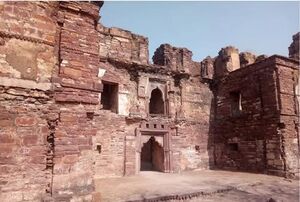
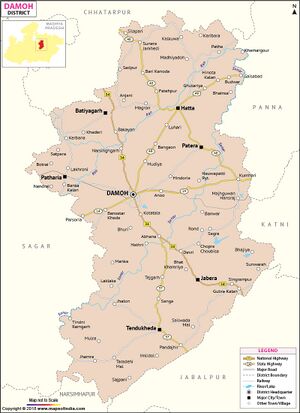
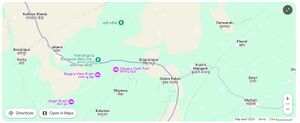
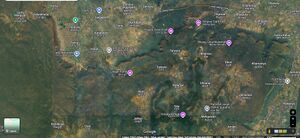
Singorgarh (सिंगौरगढ़) is a fort located in Damoh district of Madhya Pradesh, India. Singorgarh fort is about 45 km from Jabalpur city, on the way to Damoh town. It is managed by Archaeological Survey of India (ASI) Jabalpur Circle (S.No. N-MP-46). Author (Laxman Burdak) visited it on 17.02.1992.
There was civilization here in older times. King Vain Bason/ Vain Basore had built a big and strong fort and the Gawe kings ruled over here for a long time. There is also a lake here, which is full of lotus flowers. This is an ideal picnic spot.[1]
Location
It is located about 10 km off road from Sangrampur village on Jabalpur-Damoh road near the border of Jabalpur district.
Variants
- Singaurgarh सिंगौरगढ़, जिला दमोह, म.प्र. (AS, p.957)
- Singhorgarh (सिंघोरगढ़)
- Singorgadh (सिंगोरगढ़)
- Gaja-Sihgha Durga (गजसिंह दुर्ग): named after a Pratihara king Gaja-Singha (गजसिंह). General Cunningham thinks that Singorgadh is derived from this name. [2]
- Singoragadha (सिंगोरगढ़)
- Shrigauri-gadha/Shrigaurigadha (श्रीगौरीगढ़) is mentioned in (112) Tharraka Sati Inscriptions of 1513, 1514 AD. It mentions Tharraka (ठर्रका) as included in Shrigadha Gauri Vishaye Durge (श्रीगढ़ गौरी विषये दुर्गे), which furnishes a clue to the real derivation of Singoragadha fort from Shrigauri-gadha (श्रीगौरी-गढ़).[3]
Jat Gotras Namesake
- Gauri (Jat clan) (गौरी) → Shrigauri-gadha (श्रीगौरी-गढ़). Shrigauri-gadha (श्रीगौरी-गढ़) is the origin of the name Singoragadha. (112) Tharraka Sati Inscriptions of 1513 AD[4] contains five Sati pillars reoffering to the Gond regime. One is dated in samvat 1570 (1513 AD) during the reign of Amhandasadeva (आम्हणदासदेव) surname Sangram Sahi (संग्राम साही), the greatest king of the Gond dynasty. It mentions Tharraka (ठर्रका) as included in Shrigadha Gauri Vishaye Durge (श्रीगढ़ गौरी विषये दुर्गे), which furnishes a clue to the real derivation of Singoragadha fort from Shrigauri-gadha (श्रीगौरी-गढ़), fancifully derived by Cunningham from Gajasimha Durga, a name which appears to have been imposed by a Parihara Raja Gajasmha, but the old name asserted itself when the Parihara rule vanished. We know that Gauri (गौरी) is a gotra of Jats[5], name of Parvati, name of a River in Mahabharata. Gauri (गौरी) is mentioned by Panini in Ashtadhyayi.
- Sanghar (Jat clan) → Rao Sanghar. Rao Sanghar was a Barad clan Jat ruler in Punjab during the period of Emperor Babar. Rao Sanghar probably gave name to Singorgarh (सिंगौरगढ़). We know that one hero Kāī (काई) is mentioned Damoh Stone Inscription of Vijayasimha, which tells us that Vijayapala conquered a great hero named Kāī. Who was Kai? It is not clear. We find one Kai in genealogy of Barar Jat clan in Punjab. Further research is needed in this matter. Lepel H. Griffin[6] writes that founder of Barar clan Rao Barar had two sons, Rao Paur and Rao Dhul, the younger of whom is the ancestor of the Raja of Faridkot, and of the Barar tribe, which holds almost the whole of the districts of Mari, Mudki and Muktsar, Buchan, Mehraj, Sultan Khan and Bhadour in the Firozpur district, the whole of Faridkot, and many villages in Pattiala, Nabha, Jhumba and Malod. The two brothers quarreled, and the elder, Rao Paur, being worsted, fell into great poverty, in which his family remained for several generations, till Rao Sanghar restored their fortunes. {Rao Barar → Rao Paur (+ Rao Dhul) → Rao Bairath → Kai → Bao → Rao Sanghar → Bariam (d.1560)}. If we assume 25 years as a period of one generation Kai must have been present around 1535 AD.
- Singhar (सींघड़) (Jat clan) → Singorgarh (सिंगौरगढ़). Singorgarh (सिंगौरगढ़) is a fort located in Damoh district of Madhya Pradesh, India. Singorgarh fort is about 45 km from Jabalpur city, on the way to Damoh town. There was civilization here in older times. King Vain Bason/ Vain Basore had built a big and strong fort and the Gawe kings ruled over here for a long time. There is also a lake here, which is full of lotus flowers. This is an ideal picnic spot.[7]
- Singroha (सिंगरोहा) (Jat clan) → Singorgarh (सिंगौरगढ़). Singorgarh (सिंगौरगढ़) is a fort located in Damoh district of Madhya Pradesh, India. Singorgarh fort is about 45 km from Jabalpur city, on the way to Damoh town. There was civilization here in older times. King Vain Bason/ Vain Basore had built a big and strong fort and the Gawe kings ruled over here for a long time. There is also a lake here, which is full of lotus flowers. This is an ideal picnic spot.[8]
History
It is a hill-fort of Garha Kingdom which is spread over hills in a forested area. It was a magnificent fort and residence of Rajgond rulers of Central India. They spend some times of a year in Singorgarh fort. At present, fort is in a ruined condition with no caretaker. It is located inside forest area and there is no proper road to reach the site. By looking at current ruined site, one can realize that during its peak days, thousands of people were living here and fort was spread over large area and many watch towers are still visible in this area. There is pond also in hill-top which was basically for water arrangement. During last war of Garha Kingdom dynasty, under rule of Rani Durgavati, fort received major blow of first attack in June-1564. During those days, Rani Durgavati was staying in same Singorgarh Fort and later shifted to Chouragarh fort of Narsinghpur.
Before coming in hand of Gond rulers, Singorgarh fort was under Chandel rulers in 1308. It was Gond ruler Sangram shah who conquered the Singorgarh fort in early period of 16th century. Sangram Shah was a powerful Gond ruler and was Father in Law of Rani Durgavati. It was year 1564 when Mughal army, led by Asaf Khan (from Kunda, Uttar Pradesh), with assistance of Rewa rulers, attacked the Gond Kingdom. In those days, Mughal ruler Akbar ordered his general Asaf Khan of Kunda, to attack the Gond dynasty as he was jealous of Gond dynasty's prosperity and sovereignty. In summers of year 1564, Mughal army reached Gond kingdom border. During that time, Rani Durgavati was ruling the kingdom and was present in same Singorgarh fort. When she came to know about the huge army of more than 70,000 soldiers, she decided to leave the fort and shifted to Garha fort of Jabalpur and major war took place in this area. While marching towards Jabalpur, Mughal army first reached Singorgarh fort and attacked here in which fort was badly damaged and since then, although ruled but never gained its previous prosperity and gleam.
Singorgarh Fort
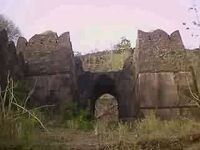
Singhorgarh (सिंगौरगढ़): Singhorgarh Fort is place of historical importance. Gond Rajas stayed in it for a long time. It was with Gond Raja Dalpat Shah and his Rani Durgawati at the end of 15th century. After the death of Raja Dalpat Shah, the Senapati of the army of Mughal emperor Akbar had a battle with Rani Durgawati at the village, Singrampur. About 6 km. away from Sigrampur the ruins of a fort of an historical importance can be found. There was civilization here in older times. King Vain Bason/ Vain Basore had built a big and strong fort and the Gawe kings ruled over here for a long time. There is also a lake here, which is full of lotus flowers. This is an ideal picnic spot.[9]
Singorgarh Fort, is a hill-fort located in Damoh district in the Madhya Pradesh state of Central India. It is about 45 km from Jabalpur city, on the way to Damoh town. It is presently under the Archeological Survey of India.[10]
In its peak years, thousands of people lived in the fort, which was spread over large area. Many of its former watch towers are still visible. The fort was attacked in June of 1564 during the invasion of the Garha Kingdom by the Mughal forces. At that time, Rani Durgavati, the ruling Queen of Gondwana, resided there; she later moved to Chouragarh Fort in Narsinghpur.
Etymology:
Origin from Gajasimhadurga: Alexander Cunningham and other archaeologists believe that the name "Singorgarh" is derived from Gajasimhadurga meaning "fortress of Gaj Singh".[11] The earliest inscription found in Singorgarh is dated 1307 AD and the fort is called Gaja-Singhadurggye, meaning the "hill fortress of Gaja Singh".[12] Gajsimha or Gaja Singh Pratihar was a Pratihara ruler after whom the fort is believed to be named.[13][14]
Origin from Shrigauri-gadha (श्रीगौरी-गढ़): The theory of origin of name Singorgarh from Gajasimhadurga by Alexander Cunningham and other archaeologists has been proved wrong by (112) Tharraka Sati Inscriptions of 1513 AD.[15] Tharraka (ठर्रका) is a deserted village, 15 miles from Damoh near the village Nayagaon. It contains five Sati pillars reoffering to the Gond regime. One is dated in samvat 1570 (1513 AD) during the reign of Amhandasadeva (आम्हणदासदेव) surname Sangram Sahi (संग्राम साही), the greatest king of the Gond dynasty. It mentions Tharraka (ठर्रका) as included in Shrigadha Gauri Vishaye Durge (श्रीगढ़ गौरी विषये दुर्गे), which furnishes a clue to the real derivation of Singoragadha fort from Shrigauri-gadha (श्रीगौरी-गढ़), fancifully derived by Cunningham from Gajasimha Durga, a name which appears to have been imposed by a Parihara Raja Gajasmha, but the old name asserted itself when the Parihara rule vanished. [16]
History: Singorgarh is believed to have been founded by the Pratiharas, who ruled in the Damoh region during the 14th century. Behram H. Mehta states that the fort was built by the Pratiharas and later strengthened by the Gonds of Garha Kingdom.[17] The known Pratihar rulers of Singorgarh are Gajsimha or Gaja Singh Pratihar, Maharajaputra Sri Vaghadeva and Kumara Shri Vaghadeva.[18] Maharajaputra Shri Vaghadeva was a feudatory of the Chandela king Bhojavarman (1285-1288 CE) and Hammiravarman (1288-1311 CE).[19] The Pratihara rule over Singorgarh probably ended with the invasion of the Delhi Sultan Ala-ud-din Khalji's forces, who were going to the Deccan and conquered Bundelkhand on their march.[20]
In the 16th century, the fort was conquered by the Gond ruler of Garha-Katanga, Sangram Shah.
Accessibility: It is about 45km from Jabalpur city, on the way to Damoh town. The fort is 4 miles away from the nearest settlement, the Singrampur town, and 28 miles south-east of Damoh town.[21] The site must be accessed by bike, car or bus as there is proper road to it.[22]
Singorgadh Stone Inscription 1307 AD
Source - Hira Lal:Descriptive lists of inscriptions in the Central provinces and Berar, p.49-50
Singorgadh is a hill fort 28 miles south-east of Damoh. Here on a monolith known as Kirttistambha there is an inscription of 8 lines, dated in the Samvat year 1364 or
[p.50]: A. D. 1307, on the Vijaya Dasami or Dasahara day. In this inscription the hill is called Gaja-Sihgha Durga, named after a Pratihara king Gaja-Singha. General Cunningham thinks that Singorgadh is derived from this name. In another pillar found in the fort an inscription of 21 lines was found, but the date given in it is not legible.
Wiki editor Notes:
- Sanghar (Jat clan) → Rao Sanghar. Rao Sanghar was a Barad clan Jat ruler in Punjab during the period of Emperor Babar. Rao Sanghar probably gave name to Singorgarh (सिंगौरगढ़). We know that one hero Kāī (काई) is mentioned Damoh Stone Inscription of Vijayasimha, which tells us that Vijayapala conquered a great hero named Kāī. Who was Kai? It is not clear. We find one Kai in genealogy of Barar Jat clan in Punjab. Further research is needed in this matter. Lepel H. Griffin[23] writes that founder of Barar clan Rao Barar had two sons, Rao Paur and Rao Dhul, the younger of whom is the ancestor of the Raja of Faridkot, and of the Barar tribe, which holds almost the whole of the districts of Mari, Mudki and Muktsar, Buchan, Mehraj, Sultan Khan and Bhadour in the Firozpur district, the whole of Faridkot, and many villages in Pattiala, Nabha, Jhumba and Malod. The two brothers quarreled, and the elder, Rao Paur, being worsted, fell into great poverty, in which his family remained for several generations, till Rao Sanghar restored their fortunes. {Rao Barar → Rao Paur (+ Rao Dhul) → Rao Bairath → Kai → Bao → Rao Sanghar → Bariam (d.1560)}. If we assume 25 years as a period of one generation Kai must have been present around 1535 AD.
- Singhar (सींघड़) (Jat clan) → Singorgarh (सिंगौरगढ़). Singorgarh (सिंगौरगढ़) is a fort located in Damoh district of Madhya Pradesh, India. Singorgarh fort is about 45 km from Jabalpur city, on the way to Damoh town. There was civilization here in older times. King Vain Bason/ Vain Basore had built a big and strong fort and the Gawe kings ruled over here for a long time. There is also a lake here, which is full of lotus flowers. This is an ideal picnic spot.[24]
- Singroha (सिंगरोहा) (Jat clan) → Singorgarh (सिंगौरगढ़). Singorgarh (सिंगौरगढ़) is a fort located in Damoh district of Madhya Pradesh, India. Singorgarh fort is about 45 km from Jabalpur city, on the way to Damoh town. There was civilization here in older times. King Vain Bason/ Vain Basore had built a big and strong fort and the Gawe kings ruled over here for a long time. There is also a lake here, which is full of lotus flowers. This is an ideal picnic spot.[25]
(112) Tharraka Sati Inscriptions of 1513, 1514 AD
Source - Inscriptions in the Central Provinces and Berar by Rai Bahadur Hira Lal, Nagpur, 1932,p.61
[p.61]: Tharraka (ठर्रका) is a deserted village, 15 miles from Damoh near the village Nayagaon. It contains five Sati pillars reoffering to the Gond regime. One is dated in samvat 1570 (1513 AD) during the reign of Amhandasadeva (आम्हणदासदेव) surname Sangram Sahi (संग्राम साही), the greatest king of the Gond dynasty. It mentions Tharraka (ठर्रका) as included in Shrigadha Gauri Vishaye Durge (श्रीगढ़ गौरी विषये दुर्गे), which furnishes a clue to the real derivation of Singoragadha fort from Shrigauri-gadha (श्रीगौरी-गढ़), fancifully derived by Cunningham from Gajasimha Durga, a name which appears to have been imposed by a Parihara Raja Gajasmha, but the old name asserted itself when the Parihara rule vanished. The second Sati stone is dated in samvat 1571 (=1514 AD), in which the name of the ruling king is given as Amanadasa (अमानदास). Two others are dated in samvat 17-7 and 1736 (=1679 AD), in the reign of Gond King Chhattra Sahi. The fifth is illegible.
सिंगौरगढ़ (जिला दमोह, म.प्र.)
सिंगौरगढ़ (AS, p.957) का ऐतिहासिक किला जिला दमोह, म.प्र. में स्थित है. गढ़मंडला की रानी वीरांगना दुर्गावती के ससुर राजा संग्रामसाह (मृत्यु 1540) के 52 गढों में सिंगौरगढ़ की भी गणना थी. संग्रामशाह के पुत्र और दुर्गावती के पति दलपतशाह ने मदनमहल (जबलपुर के निकट) को छोड़कर सिंगौरगढ़ में अपनी राजधानी बनाई थी. उन्होंने यहां के किले को बढ़ाकर उसे सुदृढ़ बनाया था. यह किला परिहार राजपूतों के समय में निर्मित हुआ था. गौंड राजाओं के समय के अवशेष भी यहां से प्राप्त हुए हैं. [26]
सिंगौरगढ़ किला
सिंगोरगढ़ : सिंग्रामपुर से 6 किलोमीटर दूर एक पहाड़ी किले पर बसा ऐतिहासिक महत्व का गांव जो आरक्षित वन कक्ष 309 एवं 312 में स्थित है. यहां राजा वेन वसोन ने मजबूत एवं बड़ा किला बनवाया था, जिस पर बहुत समय तक गोंड राजाओं का राज्य रहा है. 15 वीं शताब्दी के अंत में गोंड राजा दलपति शाह अपनी रानी दुर्गावती के साथ यहीं रहता था. राजा की मृत्यु के बाद रानी दुर्गावती का मुगल बादशाह अकबर के सेनापति आसफखां से यहां घमासान युद्ध हुआ था. किले के भीतर एक तालाब है जहां 12 महीने पानी रहता है. यहां लोक निर्माण विभाग का एक जीर्ण-शीर्ण विश्रामगृह है और वन्य प्राणियों को देखने के लिए एक वॉच टावर है. गर्मी के समय यहां पानी पिने के लिए आने वाले शेर को आसानी से देखा जा सकता है. [27]
संग्रामपुर
संग्रामपुर (AS, p.928) = सिंग्रामपुर दमोह ज़िला , मध्य प्रदेश का ऐतिहासिक स्थान है। यह सिंगौरगढ़ से प्रायः चार मील दूर वह स्थल है, जहां गढ़मंडला की वीरांगना रानी दुर्गावती और मुग़ल बादशाह अकबर की सेनाओं में घोर युद्ध हुआ था, जिसके फलस्वरूप रानी वीरतापूर्वक लड़ते हुए मारी गई थी। इस स्थान पर हुए युद्ध में अकबर की सेना आसफ़ ख़ाँ अध्यक्षता में थी। रानी दुर्गावती का स्मारक उनकी मृत्यु के स्थान पर अभी तक वर्तमान में है। संग्रामपुर ग्राम राजा संग्रामसिंह के नाम पर प्रसिद्ध है, जो रानी दुर्गावती के श्वसुर थे। इनकी मृत्यु 1540 ई. में हुई थी।[28]
सिंगोरगढ़ किला, सिंग्रामपुर गांव, दमोह जिला, मध्य प्रदेश
16वीं शताब्दी की शुरुआत में गोंडवाना के गढ़ मंडला राज्य के महाराजा संग्राम शाह द्वारा जीते गए बावन किलों में से चौथा किला दमोह जिले के सिंग्रामपुर गांव में एक पहाड़ी की चोटी पर स्थित अभेद्य सिंगोरगढ़ किला है। यह पहाड़ी किला गोंडवाना की शासक रानी दुर्गावती की वीरता और शहादत के लिए सबसे प्रसिद्ध है।
महाराजा संग्राम शाह ने अपने बेटे दलपत शाह की शादी कालिंजर के राजा कीर्ति सिंह चंदेल की बेटी रानी दुर्गावती से इसी किले में करवाई थी। कुछ ही सालों में अपने ससुर और पति की मृत्यु के बाद रानी दुर्गावती ने गोंडवाना साम्राज्य की बागडोर संभाली। उन्होंने सिंगोरगढ़ को राजधानी बनाया और अपने विश्वस्त मंत्रियों और बेटे वीर नारायण के साथ मिलकर समृद्ध राज्य का संचालन किया।
यह किला घने जंगलों वाली सतपुड़ा रेंज में स्थित है और कहा जाता है कि इसका निर्माण राजा वेन बसोर ने करवाया था और गोंडों ने इसका जीर्णोद्धार और विस्तार किया था। भूमि की बनावट, चारों तरफ पहाड़ियाँ, घने जंगल और पहाड़ियों के बीच से किले में जाने वाले असंख्य रास्तों के कारण दुश्मनों के लिए इस किले तक पहुँचना और हमला करना मुश्किल था। सैनिकों के बंकरों को पहचानना मुश्किल है और सैनिकों और रानी की आवाजाही के लिए कई छिपे हुए रास्ते बनाए गए थे, ताकि कोई उन्हें न देख सके। दुश्मन की हरकतों पर नज़र रखने के लिए प्राचीर पूरी तरह सुसज्जित थी।
स्थानीय लोगों के अनुसार, इस किले में कई गुप्त रास्ते हैं जो आक्रमणकारियों को भ्रमित करने और राजा और रानी के अनुचरों के लिए सुरक्षित मार्ग प्रदान करने के लिए बनाए गए थे। इन रास्तों का निर्माण एक वास्तुशिल्प चमत्कार माना जाता है। ऐसा कहा जाता है कि काल कोठरी के अंदर गहरी सुरंगें हैं जो केवल रानी दुर्गावती और उनकी मुट्ठी भर सेना को ही पता थीं। भारतीय पुरातत्व सर्वेक्षण (एएसआई) द्वारा खोजी गई एक सुरंग के बारे में कहा जाता है कि वह मदन महल के पहाड़ी किले तक जाती है ।
इस किले के विशाल दरवाज़े और एक बड़ा हिस्सा स्थानीय रूप से उपलब्ध पत्थरों से बनाया गया है जो इतनी सारी सदियों के बाद भी खड़े हैं। आंतरिक महलों और कमरों को इस तरह से डिज़ाइन किया गया है कि किले के सबसे गहरे हिस्सों में भी हवा और सूरज की रोशनी का निर्बाध प्रवाह होता है।
किले के अंदर रानी महल, हाथी दरवाज़ा और एक विशाल स्नान कुंड के खंडहर देखे जा सकते हैं । हाथी दरवाज़े से थोड़ी दूर पर शानदार सिंगोरगढ़ जलाशय है जो गर्मियों के दिनों में भी हमेशा पानी से भरा रहता है। ऐसा कहा जाता है कि रानी दुर्गावती को इस कुंड में स्नान करना बहुत पसंद था और इसलिए दलपत शाह ने इसे कमल से भरकर सुंदर बनाया।
स्थानीय लोगों का कहना है कि इस जलाशय के अंदर एक कुआं है, जिसमें रानी दुर्गावती का बेशुमार खजाना और पारस पत्थर छिपा हुआ है। कई लोगों ने वर्षों से जलाशय में पानी की खोज करने की कोशिश की है, लेकिन जलाशय की गहराई भ्रामक होने के कारण वे असफल रहे हैं। ऐसा कहा जाता है कि कई लालची लोगों ने खजाने को खोजने के लिए किले के विभिन्न हिस्सों में खुदाई की है, लेकिन उन्हें बहुत बड़ी दुर्भाग्य या पागलपन का सामना करना पड़ा है।
रानी दुर्गावती ने कई कुएं, टैंक, धर्मशालाएं और मठ बनवाए । उनके शासनकाल में गोंडवाना साम्राज्य का कद और समृद्धि बढ़ी और पड़ोसी राजा उससे ईर्ष्या करने लगे। इसके कारण मुगल सेनापति बाज बहादुर ने इस समृद्ध राज्य पर कई आक्रमण किए, जिन्होंने इस समृद्ध राज्य पर कब्जा कर लिया। हालांकि, उन्हें हर बार हार का सामना करना पड़ा और अंत में अकबर ने आसफ खान को सिंगोरगढ़ को हड़पने के लिए भेजा। आसफ खान को अपने पहले प्रयास में निर्णायक रूप से पराजित किया गया, लेकिन फिर वह फिर से संगठित हुआ और दस हजार से अधिक घोड़ों और पैदल सेना के साथ वापस आया। रानी दुर्गावती के पास पर्याप्त सैनिक नहीं थे और उन्होंने चुपचाप कुछ लोगों को किले की देखभाल के लिए छोड़ दिया और लगभग पांच हजार घोड़ों और पैदल सेना के साथ नरई नाला की ओर चल पड़ीं और आसफ खान के आने का इंतजार करने लगीं। यह स्थान गौर और नर्मदा नदियों के बीच स्थित है।
आसफ खान ने सिंगोरगढ़ पहुंचकर आसानी से उस पर कब्ज़ा कर लिया, लेकिन पाया कि रानी दुर्गावती भाग निकली थीं। फिर उनकी सेना ने घने जंगल में खोज की और आखिरकार उन्हें नरई नाला में देखा। यह वह जगह है जहाँ रानी दुर्गावती और मुगल आक्रमणकारी आसफ खान के बीच महान युद्ध लड़ा गया था जिसके परिणामस्वरूप उनकी मृत्यु हो गई थी। नरई नाला में रानी दुर्गावती और उनके हाथी सरमन की समाधि है।
सिंगोरगढ़ किला इतिहास, गोंडवाना साम्राज्य की भव्यता और रानी दुर्गावती की बहादुरी से भरा हुआ है, जिन्होंने मुगलों के अधीन होने और कब्जा करने के बजाय मौत को चुना। दुर्भाग्य से, यह स्थान जीर्ण-शीर्ण अवस्था में है और किले के लेआउट को समझने के लिए किसी को अपनी कल्पना का उपयोग करना होगा। यह किला जंगली जानवरों, साँपों और अन्य से भरे घने जंगल के एक अलग हिस्से में है और यहाँ बहुत कम आगंतुक आते हैं। सिंगोरगढ़ किला भारतीय पुरातत्व सर्वेक्षण (एएसआई) का एक संरक्षित स्मारक है।
स्रोत: [सुब्रमण्यन]
श्रीगौरी-गढ़
ठर्रका: दमोह जिले कि जबेरा तहसील में नयागांव के पास ठर्रका नामक गांव में मिले संवत 1570 (1513 ई.) के सती शिलालेख में गोंड राजा संग्राम शाह को आम्हणदासदेव लिखा है. इस शिलालेख में ठर्रका गाँव को 'श्रीगढ़गौरी विषये दुर्गे' के अंतर्गत बताया गया है. इससे यह प्रमाणित होता है कि सिंगौरगढ़ किले का प्राचीन नाम श्रीगौरी-गढ़ था.[29]
External links
Gallery
-
Singorgarh, Photo courtesy-CS Pandey
-
Singorgarh, Photo courtesy-CS Pandey
-
Singorgarh, Photo courtesy-CS Pandey
-
Rani Durgawati Sangrahalay Damoh, Photo courtesy-CS Pandey
-
, Photo courtesy-CS Pandey
-
Devi Rukmini (Amba Devi), Gyaraspur, Vidisha (8-9 Century) at Rani Durgawati Sangrahalay Damoh. , Photo courtesy-CS Pandey
-
Hegreev, Mohad Damoh (10-11 Century), Rani Durgawati Sangrahalay Damoh. , Photo courtesy-CS Pandey
-
Abhigyan Ram, Dhauni Damoh, Rani Durgawati Sangrahalay Damoh. , Photo courtesy-CS Pandey
References
- ↑ https://damoh.nic.in/en/places-of-interest/
- ↑ Hira Lal:Descriptive lists of inscriptions in the Central provinces and Berar, p.49-50
- ↑ Inscriptions in the Central Provinces and Berar by Rai Bahadur Hira Lal, Nagpur, 1932,p.61
- ↑ Inscriptions in the Central Provinces and Berar by Rai Bahadur Hira Lal, Nagpur, 1932,p.61
- ↑ डॉ पेमाराम:राजस्थान के जाटों का इतिहास, 2010, पृ.299
- ↑ The Rajas of the Punjab by Lepel H. Griffin/The History of the Patiala State,pp.4-5
- ↑ https://damoh.nic.in/en/places-of-interest/
- ↑ https://damoh.nic.in/en/places-of-interest/
- ↑ https://damoh.nic.in/en/places-of-interest/
- ↑ Archaeological Survey of India Jabalpur Circle".
- ↑ Bhattacharyya, Pranab Kumar (2010). Historical Geography of Madhyapradesh from Early Records. Motilal Banarsidass Publishers. ISBN 978-81-208-3394-4.
- ↑ Hīra Lāl, Rai Bahadur (1932). Inscriptions in the Central Provinces and Berar (2 ed.). Nagpur: Government Print, Central Provinces. p. 55-56.
- ↑ Archaeological Survey of India Jabalpur Circle". asijabalpur.gov.in.
- ↑ Cunningham, Alexander (1879). Report of tour in the Central Provinces, 1873-1874 and 1874-1875, Volume 9. Superintendent of Government Print., India.
- ↑ Inscriptions in the Central Provinces and Berar by Rai Bahadur Hira Lal, Nagpur, 1932,p.61
- ↑ Hiralal's Damoh Dipaka, 2nd edition, page 81
- ↑ Mehta, Behram H. (1984). Gonds of the Central Indian Highlands, Volume II. Concept Publishing Company.
- ↑ Hīra Lāl, Rai Bahadur (1932). Inscriptions in the Central Provinces and Berar (2 ed.). Nagpur: Government Print, Central Provinces. p. 55-56.
- ↑ Thomas, F.W., Epigraphia Indica, Vol XVI, p.10-11
- ↑ Thomas, F.W., Epigraphia Indica, Vol XVI, p.10-11
- ↑ The Central Provinces Gazette (28 October 1922), p.1114
- ↑ "President Inaugurates conservation works at Singorgarh Fort in Damoh district (MP)". pib.gov.in.
- ↑ The Rajas of the Punjab by Lepel H. Griffin/The History of the Patiala State,pp.4-5
- ↑ https://damoh.nic.in/en/places-of-interest/
- ↑ https://damoh.nic.in/en/places-of-interest/
- ↑ Aitihasik Sthanavali by Vijayendra Kumar Mathur, p. 957
- ↑ एल आर बुरडक, मध्य प्रदेश शासन वन विभाग, दमोह वन मंडल की कार्य-आयोजना (1993-94 से 2002-03), p.228-229
- ↑ Aitihasik Sthanavali by Vijayendra Kumar Mathur, p.928
- ↑ Inscriptions in the Central Provinces and Berar by Rai Bahadur Hira Lal, Nagpur, 1932,p.61









